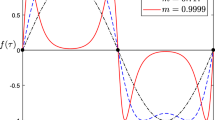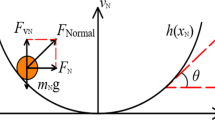Abstract
Period-adding bifurcations and period-doubling bifurcations of neural firing patterns, which were both observed in the biological experiment on a neural pacemaker and simulated in a theoretical model (Chay model), manifested different stochastic dynamics near the bifurcation points. For period-adding bifurcations, a noise-induced stochastic bursting, whose behavior is stochastic transition between period-k and period-(\(k+1\)) bursts, lying between period-k and period-(\(k+1\)) burstings (\(k=1,2,3\)). For period-doubling bifurcations, period-1 bursting is changed to period-2 bursting firstly and then to period-4 bursting. No stochastic firing patterns similar to those lying in the period-adding bifurcation were detected. Using the method of the fast–slow variables dissection, the deterministic burstings in both period-adding bifurcation and period-doubling bifurcation are classified into “fold/homoclinic” bursting with a saddle-node point and a saddle-homoclinic point, which behaves as a critical phase sensitive to noisy disturbance. For the bursting pattern near the period-doubling bifurcation point, the trajectory of burstings is far from the saddle-homoclinic point. Near the period-adding bifurcation points from period-k to period-(\(k+1\)) burstings, the trajectories of the bursting patterns pass through the neighborhood of the saddle-homoclinic point and exhibit a platform. The platform appears after the k-th spike for the period-k bursting and between the k-th spike and the (\(k+1\))-th spike for the period-(\(k+1\)) bursting. For some bursts of period-k bursting, noise can induce a novel spike near the platform to form a burst with \(k+1\) spikes, and for some bursts of period-(\(k+1\)) bursting, the last spike can be terminated by noise to form a burst with k spikes. It is the cause that the stochastic bursting whose behavior is stochastic transition between period-k burst and period-(\(k+1\)) burst is induced by noise, and the stochastic transition happens within or near the platform, i.e., the neighborhood of the saddle-homoclinic point. More detailed transition dynamics can be explained by the stable/unstable manifold of the saddle point. The underlying deterministic dynamics between period-adding and period-doubling bifurcation points that can lead to distinct stochastic dynamics are identified, which are helpful for understanding the roles of noise and provide critical phase to apply control strategy to modulate the firing patterns.
















Similar content being viewed by others
References
Rinzel, J., Ermentrout, G.B.: Methods in Neuronal Modeling: Analysis of Neural Excitability and Oscillations, pp. 114–128. The MIT Press, Cambridge, MA (1989)
Braun, H.A., Wissing, H., Schäfer, K.: Oscillation and noise determine signal transduction in shark multimodal sensory cells. Nature 367, 270–273 (1994)
Yang, M.H., An, S.C., Gu, H.G., Liu, Z.Q., Ren, W.: Understanding of physiological neural firing patterns through dynamical bifurcation machineries. Neuroreport 17, 995–999 (2006)
Song, X.L., Wang, C.N., Ma, J., Tang, J.: Transition of electric activity of neurons induced by chemical and electric autapses. Sci. China Technol. Sci. 58(6), 1007–1014 (2015)
Terman, D.: The transition from bursting to continuous spiking in excitable membrane models. J. Nonlinear Sci. 2(2), 135–182 (1992)
Han, X., Chen, Z., Bi, Q.: Inverse period-doubling bifurcations determine complex structure of bursting in a one-dimensional non-autonomous map. Chaos 26(2), 134101–161 (2016)
Izhikevich, E.M.: Neural excitability, spiking and bursting. Int. J. Bifurcat. Chaos 10, 1171–1266 (2000)
Chay, T.R.: Chaos in a three-variable model of an excitable cell. Phys. D 16(2), 233–242 (1985)
Fan, Y.S., Chay, T.R.: Generation of periodic and chaotic bursting in an excitable cell model. Biol. Cybern. 71(5), 417–431 (1994)
Izhikevich, E.M.: Dynamical Systems in Neuroscience: The Geometry of Excitability and Bursting. MIT Press, Cambridge, MA (2007)
Ren, W., Hu, S.J., Zhang, B.J., Wang, F.Z., Gong, Y.F., Xu, J.X.: Period-adding bifurcation with chaos in the interspike intervals generated by an experimental neural pacemaker. Int. J. Bifurcat. Chaos 7(8), 1867–1872 (1997)
Gu, H.G., Pan, B.B., Chen, G.R., Duan, L.X.: Biological experimental demonstration of bifurcations from bursting to spiking predicted by theoretical models. Nonlinear Dyn. 78, 391–407 (2014)
Gu, H.G.: Different bifurcation scenarios of neural firing patterns observed in the biological expermient on identical pacemakers. Int. J. Bifurcat. Chaos 23, 1350195 (2013)
Gu, H.G.: Experimental observation of transition from chaotic bursting to chaotic spiking in a neural pacemaker. Chaos 23, 023126 (2013)
Rech, P.C.: Period-adding and spiral organization of the periodicity in a Hopfield neural network. Int. J. Mach. Learn. Cybern. 6(1), 1–6 (2015)
Gu, H.G., Pan, B.B.: A four-dimensional neuronal model to describe the complex nonlinear dynamics observed in the firing patterns of a sciatic nerve chronic constriction injury model. Nonlinear Dyn. 81, 2107–2126 (2015)
Qin, H.X., Ma, J., Jin, W.Y., Wang, C.N.: Dynamics of electric activities in neuron and neurons of network induced by autapses. Sci. China Technol. Sci. 57(5), 936–946 (2014)
Wang, X.J.: Genesis of bursting oscillations in the Hindmarsh–Rosemodel and homoclinicity to a chaotic saddle. Phys. D 62, 263–274 (1993)
Fan, Y.S., Holden, A.V.: Bifurcations, burstings, chaos and crises in the Rose–Hindmarsh model for neuronal activity. Chaos Solitons Fractals 3, 439–449 (1993)
Innocenti, G., Genesio, R.: On the dynamics of chaotic spiking–bursting transition in the Hindmarsh–Rose neuron. Chaos 19, 023124 (2009)
Gu, H.G., Yang, M.H., Li, L., Liu, Z.Q., Ren, W.: Experimental observation of the stochastic bursting caused by coherence resonance in a neural pacemaker. Neuroreport 13, 1657–1660 (2002)
Fan, Y.S., Holden, A.V.: From simple to complex bursting oscillatory behaviour via intermittent chaos in the Hindmarsh–Rose model for neuronal activity. Chaos Solitons Fractals 2, 349–367 (1992)
González-Miranda, J.M.: Observation of a continuous interior crisis in the Hindmarsh–Rose neuron model. Chaos 13, 845–852 (2003)
González-Miranda, J.M.: Block structured dynamics and neuronal coding. Phys. Rev. E 72, 051922 (2005)
Gu, H.G., Yang, M.H., Li, L., Liu, Z.Q., Ren, W.: Dynamics of autonomous stochastic resonance in neural period adding bifurcation scenarios. Phys. Lett. A 319(1), 89–96 (2003)
Yang, Z.Q., Lu, Q.S., Li, L.: The genesis of period-adding bursting without bursting-chaos in the Chay model. Chaos Solitons Fractals 27(3), 689–697 (2006)
Gu, H.G.: Experimental observation of transitions from chaotic bursting to chaotic spiking in a neural pacemaker. Chaos 23, 023126 (2013)
Jia, B., Gu, H.G., Li, L., Zhao, X.Y.: Dynamics of period doubling bifurcation to chaos discovered in the spontaneous neural firing pattern. Cogn. Neurodyn. 6, 89–106 (2012)
Hindmarsh, J., Rose, R.: A model of neuronal bursting using three coupled first order differential equations. Proc. R. Soc. Lond. 221, 87–102 (1984)
Holden, A.V., Fan, Y.S.: From simple to simple bursting oscillatory behaviour via chaos in the Rose–Hindmarsh model for neuronal activity. Chaos Solitons Fractals 2, 221–236 (1992)
Rech, P.C.: Dynamics of a neuron model in different two-dimensional parameter-spaces. Phys. Lett. A 375, 1461–1464 (2011)
Duan, L.X., Lu, Q.S.: Codimension-two bifurcation analysis on firing activities in Chay neuron model. Chaos Solitons Fractals 30, 1172–1179 (2006)
Lu, Q.S., Yang, Z.Q., Duan, L.X., Gu, H.Gt, Ren, W.: Dynamics and transitions of firing patterns in deterministic and stochastic neuronal systems. Chaos Solitons Fractals 40(2), 577–597 (2009)
Ma, J., Qin, H.X., Song, X.L., Chu, R.T.: Pattern selection in neuronal network driven by electric autapses with diversity in time delays. Int. J. Mod. Phys. B 29(01), 1450239 (2015)
Rinzel, J.: Mathematical Topics in Population Biology, Morphogenesis and Neurosciences: A Formal Classification of Bursting Mechanisms in Excitable Systems, pp. 267–281. Springer, Berlin (1987)
Bennett, G.J., Xie, Y.K.: A peripheral mononeuropathy in rat that produces disorders of pain sensation like those seen in man. Pain 33(1), 87–107 (1988)
Chay, T.R., Fan, Y.S., Lee, Y.S.: Bursting, spiking, chaos, fractals, and universality in biological rhythms. Int. J. Bifurcat. Chaos 5, 595–635 (1995)
Mannella, R., Palleschi, V.V.: Fast and precise algorithm for computer simulation of stochastic differential equations. Phys. Rev. A 40(6), 3381–3386 (1989)
Ma, J., Tang, J.: A review for dynamics of collective behaviors of network of neurons. Sci. China Technol. Sci. 58(12), 2038–2045 (2015)
Gu, H.G., Jia, B., Li, Y.Y., Chen, G.R.: White noise-induced spiral waves and multiple spatial coherence resonances in a neuronal network with type I excitability. Phys. A 392(6), 1361–1374 (2013)
Ma, J., Wu, Y., Ying, H.P., Jia, Y.: Channel noise-induced phase transition of spiral wave in networks of Hodgkin–Huxley neurons. Chin. Sci. Bull. 56(2), 151–157 (2011)
Touboul, J., Hermann, G., Faugeras, O.: Noise-induced behaviors in neural mean field dynamics. SIAM J. Appl. Math. 11(1), 49–81 (2012)
Nicola, W., Ly, C., Campbell, S.A.: One-dimensional population density approaches to recurrently coupled networks of neurons with noise. SIAM J. Appl. Math. 75(5), 2333–2360 (2015)
Lee, K.E., Lopes, M.A., Mendes, J.F., Goltsev, A.V.: Critical phenomena and noise-induced phase transitions in neuronal networks. Phys. Rev. E 89(89), 45–64 (2013)
Bashkirtseva, I., Neiman, A.B., Ryashko, L.: Stochastic sensitivity analysis of the noise-induced excitability in a model of a hair bundle. Phys. Rev. E 87(5), 052711 (2013)
Zakharova, A., Feoktistov, A., Vadivasova, T., Schöll, E.: Coherence resonance and stochastic synchronization in a nonlinear circuit near a subcritical Hopf bifurcation. Eur. Phys. J. Spec. Top. 222(10), 2481–2495 (2013)
Author information
Authors and Affiliations
Corresponding author
Additional information
This work was supported by the National Natural Science Foundation of China under Grant Nos. 11572225, 11372224 and 11402039, and Natural Science Foundation of Inner Mongolia Autonomous Region of China under Grant No. 2016MS0101.
Rights and permissions
About this article
Cite this article
Li, Y., Gu, H. The distinct stochastic and deterministic dynamics between period-adding and period-doubling bifurcations of neural bursting patterns. Nonlinear Dyn 87, 2541–2562 (2017). https://doi.org/10.1007/s11071-016-3210-6
Received:
Accepted:
Published:
Issue Date:
DOI: https://doi.org/10.1007/s11071-016-3210-6




